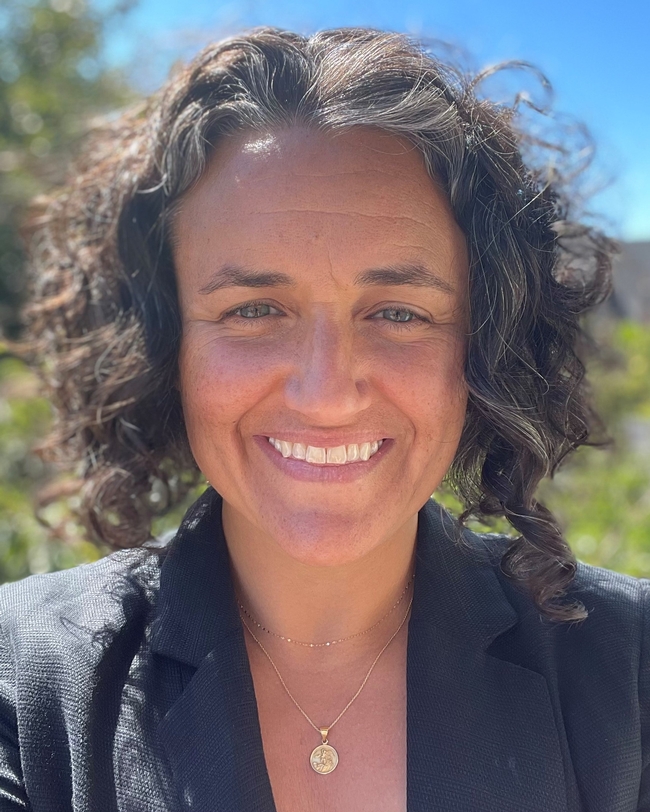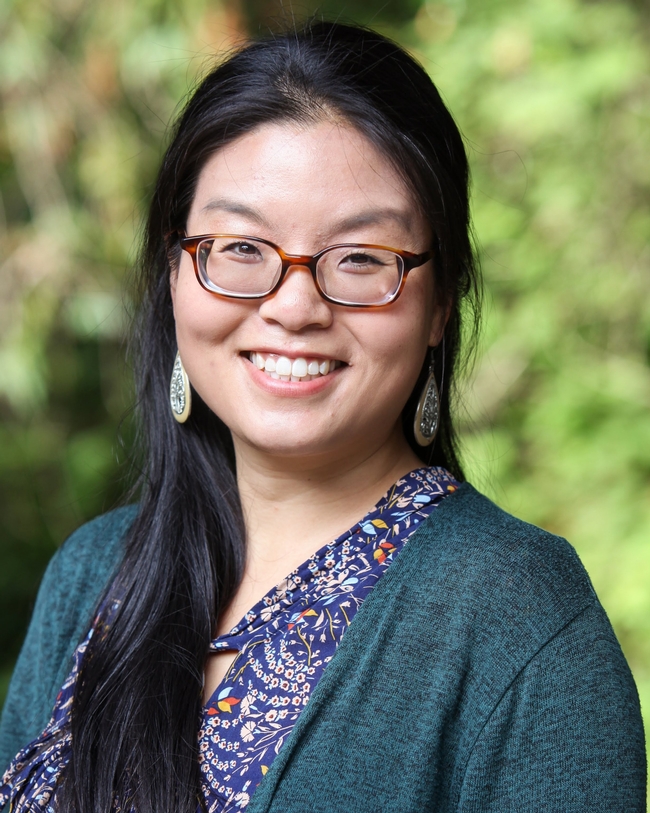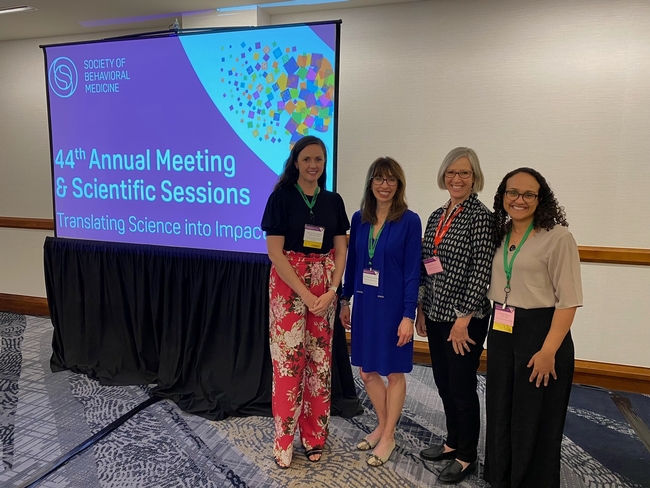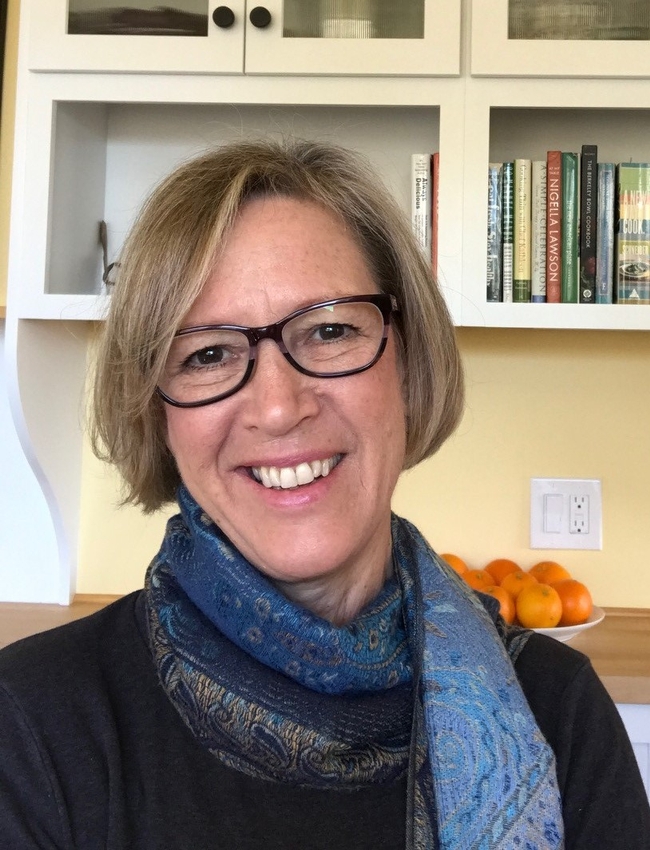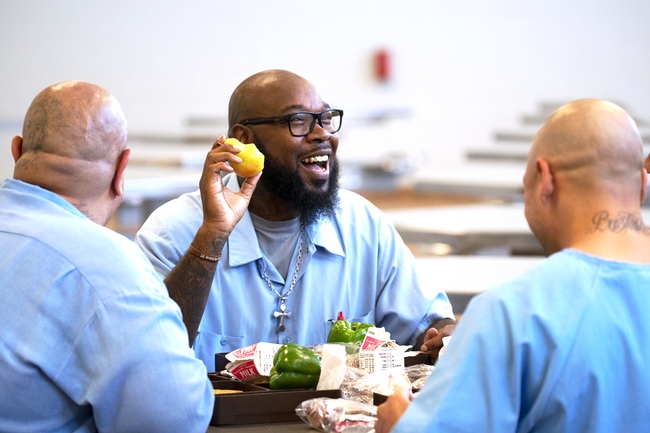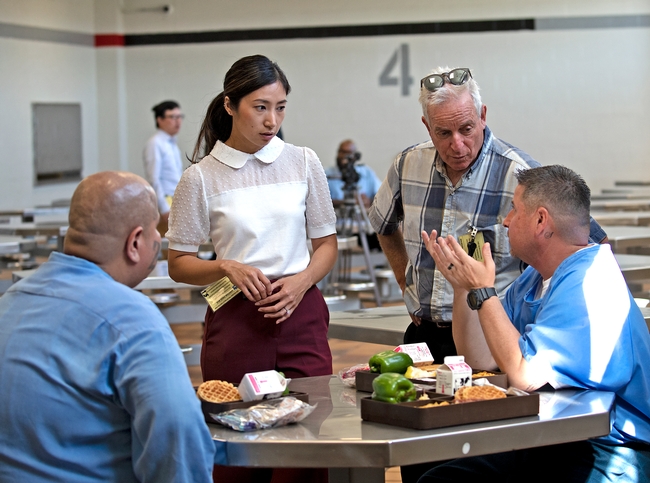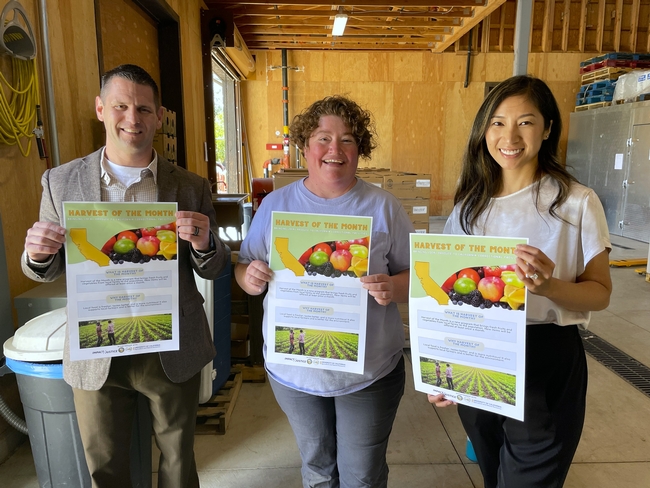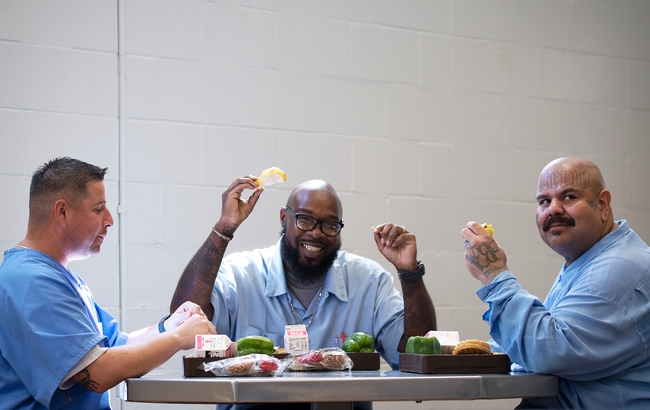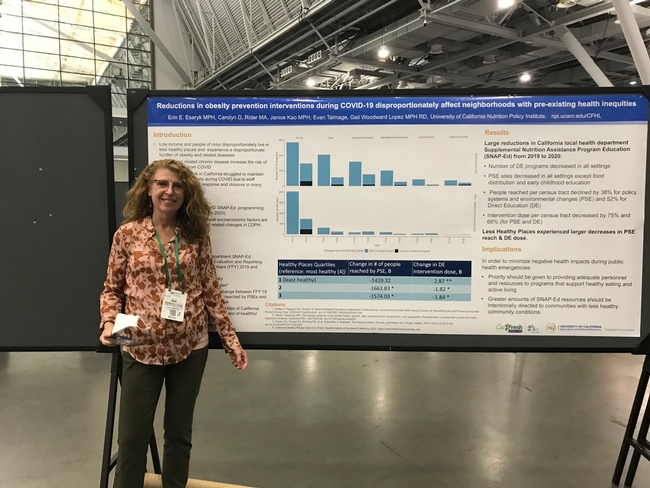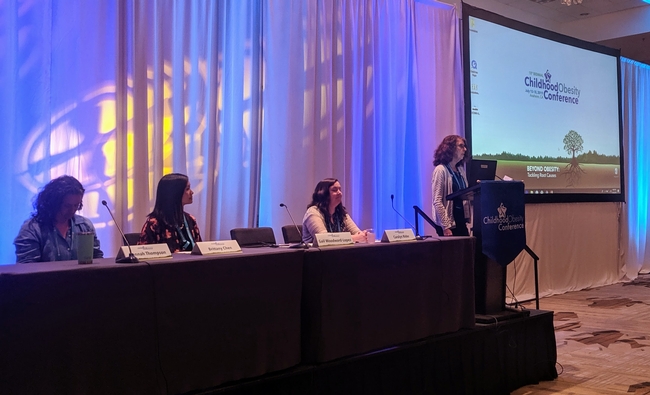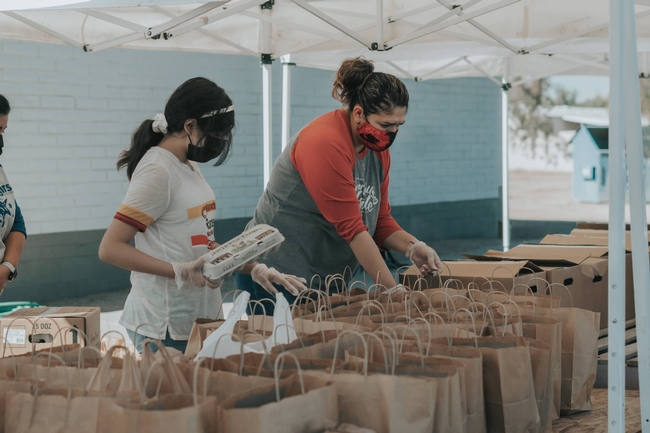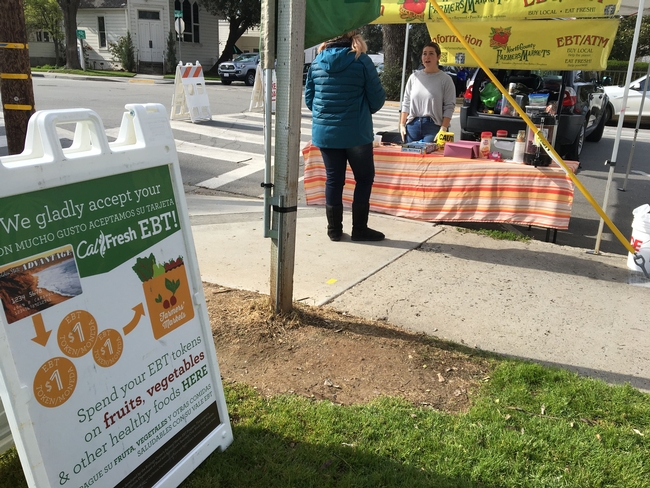Posts Tagged: NPI
NPI researchers find school recess varies with school size, family income
New law mandates at least 30 minutes of recess for K-8 public school students
Last year, while working on a bill that would require California public schools to provide at least 30 minutes of recess, State Sen. Josh Newman sought the latest research on youth physical activity. Newman, whose district encompasses parts of Los Angeles, Orange and San Bernardino counties, traveled to the Bay Area to see one of the leading experts in the field.
During several visits with Newman, Hannah Thompson – a Nutrition Policy Institute senior epidemiologist and an assistant research professor in the University of California, Berkeley School of Public Health – shared the most recent science.
Both the American Academy of Pediatrics and Centers for Disease Control and Prevention recommend that children have 20 minutes or more of daily recess. But, when asked about the current “state of recess” across California, Thompson said she only knew of anecdotal evidence at the state level.
“I said, ‘You know what? I don't actually know what is going on in California,'” Thompson recalled. “I contacted a couple of colleagues who had done more national-level work on recess that included samples of California schools – but no one was really able to disaggregate what was happening in California.”
She brought up the bill during a meeting with her fellow researchers at NPI, an institute under UC Agriculture and Natural Resources.
And it turned out that Janice Kao, an NPI academic coordinator, had exactly what she needed.
CalFresh Healthy Living evaluation team provides key recess data
Kao leads a project team that evaluates local health departments' programs of CalFresh Healthy Living – California's version of the educational arm of SNAP (the federally supported Supplemental Nutrition Assistance Program).
As part of that evaluation process, Kao's team coordinates questionnaire administration at SNAP-Ed-eligible schools that are partnering with local health departments on CalFresh Healthy Living interventions, ranging from nutrition programs to physical activity initiatives. The survey asks school administrators about their current policies, environments and practices – including the provisioning of recess.
“It was just really good luck that everything was in the right place at the right time to be able to work together,” Thompson said.
At Thompson's request, Kao and her colleagues processed and cleaned that crucial piece of data, comprising responses from 153 low-income elementary schools in the 2021-22 school year.
“Just 56% of schools reported providing more than 20 minutes of recess daily,” Kao said. “So this was a situation where the data showed, ‘OK, there is some room for improvement, perhaps at that state policy level.'”
Thompson and Rebecca London, a sociologist at UC Santa Cruz, wrote a research brief detailing their analysis of the data. They describe disparities in recess time based on school size and income level of families, with students in larger, less affluent schools generally receiving less daily recess.
Thompson said those disparities are related to funding and academic inequities, as the imperative to boost test scores forced schools to increase certain classroom hours at the expense of recess time.
“We did all this work engineering physical activity out of the school day despite the tremendous body of evidence that shows physically active kids not only are healthier but can concentrate better; they have better academic performance, fewer disruptions, better classroom behavior,” explained Thompson, a former physical education teacher in Oakland. “In trying to address that academic gap, we ended up exacerbating a lot of these public health disparities.”
Virtual learning during the pandemic showed educators and parents – firsthand – the harmful effects of children staying sedentary in front of computer screens for hours. But the resulting momentum for restoring recess and time for physical activity was soon stalled as schools tried to make up for “lost time” in returning to classrooms, Thompson said.
NPI resources, expertise invaluable to lawmakers
Newman's bill, SB 291, was an attempt to lock in those recess minutes that are crucial for student health, development and scholastic performance. Both Thompson and London testified before the Senate Education Committee in April 2023, providing the senators with science-based information and context to guide their policymaking.
“Crafting policies rooted in science is critical for legislators to ensure our policies are impactful,” Newman said. “The work of Dr. Thompson and her colleagues at UC provided clear and useful guidance on the benefits of unstructured play and how to improve health and educational outcomes in California schools.”
Gov. Gavin Newsom signed SB 291 into law last October. Starting this coming school year, public elementary and middle schools across California will be required to give at least 30 minutes of recess to K-5 students – and prohibited from withholding recess as punishment.
Kao said her team was excited that their CalFresh Healthy Living evaluation data was useful for lawmakers, illustrating NPI's important role in informing evidence-based policy.
“I'm hopeful that we can use this same data set to also provide key pieces of information on other types of legislation that's in the works, or newly passed legislation,” Kao said.
Thompson said the challenge now will be ensuring schools have the resources and funding to provide quality time for young people.
“If you only have one schoolyard, and it's already dedicated to PE, what do you do now, if you have to increase your time for recess and you don't have that space?” she said.
Thompson added that she is currently applying for a grant to study how schools across California are adjusting to meet the new requirements.
Rauzon, visionary in community health evaluation, retires from NPI
Nutrition Policy Institute researcher developed techniques that help identify effective public health programs
When Suzanne Rauzon and May Wang were in the master's of public health program at the University of California, Berkeley during the mid-1980s, Wang knew that her classmate had unique brilliance to bring to their field.
“You know how you vote for the person in high school who's most likely to succeed? That was Suzanne,” said May Wang, a professor of community health sciences in the UCLA Fielding School of Public Health. “Suzanne was always ahead of every one of us; she was so visionary and forward-thinking and I think we were all – to be honest – a little bit in awe of her.”
Decades later, as Rauzon prepares to retire in January 2024 as director of community health at the Nutrition Policy Institute, she has fulfilled that exceptional promise. Her many contributions are helping communities identify the most effective programs to benefit public health.
Lorrene Ritchie, director of NPI (an institute under UC Agriculture and Natural Resources), said that Rauzon has played a pivotal role in translating research findings into community action and policy change. She added that Rauzon has brought an extraordinary combination of strategic vision for the overall direction of nutrition studies and tactical savvy to anticipate the needs of project funders and communities.
“Few people can bring both of those skills – efficiently complete the day-to-day tasks as well as be a big-picture thinker,” Ritchie said. “She has been so instrumental in contributing to NPI's impacts.”
A unique skill set to tackle complex challenges
Part of what makes Rauzon unique in her field is her extensive experience in the private sector. After attaining her master's degree, Rauzon developed a comprehensive employee worksite wellness initiative at a telecommunications company – a new set of programs that led the field in the 1990s.
“Suzanne was, is and has always been very visionary,” Wang said.
After years in the corporate space, however, Rauzon leaped at the chance to return to academia (and reunite with Wang) in 2001 at UC Berkeley's Center for Weight and Health, a precursor to NPI. Working with center co-director Patricia Crawford, Rauzon said the project to investigate the effects of sugar-sweetened beverages was a “perfect fit” for her.
Concerned with rising childhood obesity, the researchers studied the significant differences in health outcomes for students in high schools that limited access to beverages such as soft drinks, versus schools that did not.
“That field in general – looking to limit sugar-sweetened beverages – started with a focus in schools, and expanded into other environments (such as college campuses) over the years, and has continued to be a focus in public health,” Rauzon said, “all the way up to work now on limiting sugar-sweetened beverages access in other public institutions.”
Rauzon's change-management and communication skills also were crucial in studying the revolutionary School Lunch Initiative in the Berkeley Unified School District – a collaboration with chef Alice Waters' Chez Panisse Foundation and the Center for Ecoliteracy to engage young people in the growing and preparation of food. Brought in to evaluate the efficacy of the program, Wang and Rauzon found they had to alter their mindset and methods when working with partners who were responding to oft-changing circumstances.
Rauzon's cross-sector perspective, practical know-how and people skills in cultivating positive relationships with district staff and educators were instrumental in successfully completing studies with as much rigor as possible in real-world settings such as schools.
The researchers created new analytical tools to evaluate health interventions developed by communities themselves – as opposed to programs engineered by academics and applied to community members with the expectation that they would accept it.
“Most researchers, to be honest, are still striving to do that with communities,” Wang said. “It is an incredibly challenging task because communities will do what they want to do – and what they need to do – to respond to the needs of people.”
Wang, who now trains academics in community-based participatory research, said that the ground-up paradigm has been shaped by Rauzon's thinking. “A lot of the ideas I have today really came about from our work together on the School Lunch Initiative,” Wang said.
A legacy of new methods, mentoring early-career professionals
One of Rauzon's longest-running – and most complex – projects has been the evaluation of community health interventions across the country, including a variety of Kaiser Permanente initiatives to promote healthy eating and physical activity.
“What was interesting about that work was we really were trying to understand the combined effects of doing a lot of different things that are related – and to see the overall effect that can have on the community,” said Rauzon, noting that interventions ranged from nutrition classes to policy changes to park and bike-safety improvements.
Wang said some of their findings, particularly from one study in Los Angeles County, suggest that effective programs are early childhood interventions (including an emphasis on breastfeeding), home visitations by nurses and social workers to vulnerable households, and partnerships with retailers to make healthy food choices more accessible.
In the process, the researchers helped pioneer new research tools – including interdisciplinary “systems mapping” approaches in which computer scientists discern linkages among various programs and their effects, and the highly influential “community intervention dose index” concept that can be used to evaluate multiple intervention strategies within a community.
In addition to Rauzon's contributions in research and evaluation, Ritchie also highlighted her role in supervising and mentoring students and NPI staff and researchers during her 20-plus years with the UC – the role in which Rauzon takes the most pride.
“While I made a contribution to community health in effective interventions and how to measure them,” Rauzon said, “I would say personally the most rewarding part of the work I've done over the last couple of decades is seeing the growth and development and advancement of people who have worked for me and who have really taken off in their own careers – that to me has been immensely satisfying.”
As an emeritus researcher, Rauzon will continue to support NPI professionals and their research, and she added that she's excited to embark on a new partnership – with her husband, a geographer – to mitigate impacts of climate change on human and environmental health across the globe.
People interested in supporting Rauzon's legacy and the ongoing work in health and nutrition can donate to NPI's Student Fellowship, which provides students from underrepresented groups the opportunity to work on NPI research and be mentored by NPI researchers.
‘Farm to corrections’ project provides fresh produce to people in prison, boosts California growers
Nutrition Policy Institute, Impact Justice, ChangeLab Solutions partner with California Department of Corrections and Rehabilitation
Serving slices of watermelon on the Fourth of July is a long-standing tradition at some facilities within the California Department of Corrections and Rehabilitation. But this July, there was something different about the watermelon offered to the approximately 8,000 residents at California State Prison Solano, California Medical Facility and Folsom State Prison.
It was juicy. It was sweet. It was “scrumdiddlyumptious,” according to one resident. And it was grown on a California family farm.
The three institutions are part of a “farm to corrections” project, Harvest of the Month, which aims to serve seasonal, locally grown produce to people who are incarcerated in California, while opening new opportunities for California farmers.
“We appreciate that someone cares enough to introduce this program that gives us something new,” said Jason Romero, a California State Prison Solano resident. “We look forward to what's coming in the future – California has the best stuff, right? – and hopefully we get other varieties of stuff.”
The program – bringing together the Nutrition Policy Institute, the nonprofit Impact Justice, and ChangeLab Solutions in collaboration with CDCR – was officially launched with the watermelon delivery in July. Pluots followed in August, and Bartlett pears were delivered in September.
“It's a ‘multiple wins' kind of an effort,” said Wendi Gosliner, the NPI principal investigator on the California Department of Food and Agriculture specialty crop block grant supporting the project. “The funding is available because the state is looking for state partners to purchase and expand the markets for California-grown fruits and vegetables. And we know that getting more of those fruits and vegetables on the plates of people who are incarcerated would be a huge bonus for them.”
California State Prison Solano resident Patrick Range said that, after tasting pluots for the first time through the program, the plum-apricot hybrid is now one of his favorites.
“I think I had five of them that day – and I'm waiting for them to have them again so I can get more; they were so good,” Range said. “It's something I'd never experienced, in the outside world or in prison.”
With rave reviews from residents and staff alike, CDCR – the State of California's biggest purchaser of food – is planning to roll out Harvest of the Month to all 33 of its adult facilities within the next two years.
“Food brings individuals together and introducing new products can give those in the care of CDCR something to talk about, as well as look forward to,” said Lance Eshelman, CDCR's departmental food administrator.
Improving conditions for people within correctional institutions is core to the mission of Impact Justice, which is working with partner organizations across the U.S. to bring fresher, more nutritious food to facilities, in support of residents' physical, mental and emotional health.
“We really want to prioritize the holistic well-being of an individual to help ensure that once they come home from incarceration, they are in a place where they are ready to actually contribute back to society,” said Heile Gantan, program associate with the Food in Prison project at Impact Justice.
Range said that enjoying the fresh produce – and learning more about its nutritional value – is helping him live a healthier, more energized, and hopefully longer life.
“I was a kid that didn't like vegetables; I didn't want nothing to do with vegetables…[but] as an adult, being 46 years of age, I want this for myself – I want to be able to tell someone else, to teach someone else about what I experienced when getting these fruits and vegetables that helped that nutritional factor,” he said.
In addition, Gosliner noted that early research suggests better food can benefit not only the well-being of residents but also of staff, with a calmer and safer work environment.
Partnership built on shared values, priorities
Gosliner and Ron Strochlic, academic coordinator at NPI, saw an opportunity to support “farm to corrections” work through a CDFA block grant, which aims to boost the purchase of California-grown specialty crops.
“CDCR is the state's largest single purchaser of food, so they're a natural place to consider ways to improve food systems,” said Gosliner, who was awarded the grant in 2020 to work with partners to research and develop pathways that encourage CDCR procurement of California produce, as well as nutrition programs for formerly incarcerated individuals. The project produced a report summarizing the opportunities and challenges in bringing more California-grown produce to the state's prison system.
The staff at Impact Justice appreciated that the NPI team brought not only research and evaluation acumen to the partnership but also an abiding concern for the people inside correctional facilities.
“Our grant funding was focused on simply increasing access to and consumption of California-grown specialty crops in CDCR prisons, but our team was very much in alignment around values and really focusing on the health and well-being of residents – highlighting and amplifying residents' experiences and voices,” said Leslie Soble, senior program manager of the Food in Prison Project.
Gantan echoed that sentiment, adding that NPI – which is under the University of California Agriculture and Natural Resources umbrella – also contributed its familiarity with regional food systems, particularly food hubs across the state.
According to the NPI team, engaging food hubs – organizations that aggregate, distribute and market food products from local producers – was a logical way to make a “farm to corrections” match.
“The majority of CDCR facilities are located in rural, agricultural regions, so to us, it was kind of a no-brainer to connect those facilities with the local communities and local farmers in the area,” Strochlic explained.
For the Harvest of the Month project, the partners teamed up with Spork, a Davis-based, mission-driven food hub that sources from growers across Northern California. Spork also aggregates the fresh produce from local farmers and delivers it to participating CDCR facilities each month.
“The farmers are very excited to see the change in the systems at CDCR in food and nutrition and what they're offering to the residents – and they're excited for the potential that this has for a larger, more consistent market,” said Hope Sippola, co-owner of Spork, which emphasizes working with underserved farmers as part of its mission. “We really needed to dig deep to figure out how to successfully implement this change of CDCR purchasing from large distributors to a food hub who sources from local family farms.”
Carolyn Chelius, an NPI project policy analyst and project manager of NPI's Farm-to-Corrections work, said the team hopes, as Harvest of the Month scales up, that they will be able to make Spork's generous investment of time and resources pay off.
“Our ultimate goal is to be able to benefit Spork and help them with their business, but it's been really helpful to have them as champions – people who are really interested in the mission,” Chelius said. “I don't know if this project would have been possible otherwise.”
California produce purchasing requirement helped spur project
Of course, cultivating a strong working relationship with CDCR also was essential. On the heels of AB 822 (a policy requiring state agencies to buy California-produced food over other options if the price differential is 5% or less), another powerful impetus for CDCR was the passage of AB 778 in 2022. It requires that, by the end of 2025, at least 60% of food purchased by state-run institutions must be grown or produced in California.
Eshelman, the departmental food administrator, said the law has challenged CDCR to look closely at its statewide menus and identify items that could be sourced from California growers and producers. He said that, through this project, food service team members have gained new knowledge about food production in the state, such as variability due to regional differences and weather trends.
“The Harvest of the Month program provides an additional resource, and places CDCR in contact with subject matter experts such as food hubs and local growers who can provide valuable insight into what to expect in terms of California-grown or produced food items and their accessibility,” Eshelman explained, adding that NPI and Impact Justice also have been vital resources for CDCR.
Gosliner acknowledges the challenges in retooling processes and procedures across CDCR, the second-largest correctional system in the U.S. With nearly 100,000 incarcerated individuals in its care, CDCR purchases more than $163 million in food each year.
“It's a big ask of a major state institution to reconsider some of their systems for doing something that they do every day: providing food to the people who are incarcerated,” Gosliner said. “It's revolutionary for them to rethink who they're sourcing from, to rethink how much fresh produce they're serving, to rethink the variety of that produce – it's a big lift for CDCR.”
‘This is really the beginning'
As CDCR brings Harvest of the Month to more institutions across the state, the collaborators anticipate that the logistics will smooth out – and that more farmers will be willing to participate.
“If we can add some more facilities and increase the volume, we have a better chance of making it work for growers, so we're really hoping that we can continue with this food hub model,” Strochlic said. “For us it's really important to be able to source from small and medium growers as well.”
And while flyers describing the health benefits of each month's “Harvest” item are currently distributed at the participating facilities, the partners hope they can provide additional nutrition education opportunities for the residents – during their time inside and after incarceration (like in the workshops held across the state).
Soble and Gantan of Impact Justice also noted that all members of the project team have been learning together, exploring “new territory” in growing this innovative partnership.
“I know personally I've learned so much from the NPI folks just about policy related to food and nutrition in California and about different nutrition interventions,” Soble said. “To me, it's been a very valuable and positive partnership.”
Gosliner said that building on those relationships will be crucial, as the movement to improve the services provided to incarcerated individuals continues to gain momentum in the state.
“This is really the beginning of California's work,” she said. “Even though we grow so much of the food here, there are other states in the country that are further along than we are in California. This is really the launch.”
Funding for this project was made possible by the U.S. Department of Agriculture's (USDA) Agricultural Marketing Service through grant AM200100XXXXG032. Its contents are solely the responsibility of the authors and do not necessarily represent the official views of the USDA.
Funds from UC Sustainable Agriculture Research and Education Program's Small Grants Program also helped support this project.
Woodward-Lopez retires after 23 years of leadership in advancing nutrition
Nutrition Policy Institute researcher influenced obesity research, SNAP-Ed evaluation
Young people across California and the U.S. enjoy healthier, more nutritious food options at school, thanks to the contributions of Gail Woodward-Lopez, who retired on July 1 as the associate director of research at the Nutrition Policy Institute, a part of University of California Agriculture and Natural Resources.
Woodward-Lopez officially joined UC ANR in 2015, when she and other researchers at the Atkins Center for Weight and Health at UC Berkeley merged with NPI. But her association with UC ANR goes back much further, as her work at CWH was always directed by UC Cooperative Extension academics – including the research that paved the way for California's “junk food ban” in schools.
Two bills, signed in 2005, set nutrition standards in California for “competitive foods”– the items sold in vending machines and from food service a la carte (as opposed to federally subsidized school meals). That legislation – which inspired similar policy changes across the country – was informed by the work of Woodward-Lopez and her colleagues, who had looked at the financial impact of establishing those standards.
“Our study was so pivotal that I literally had people calling me from the floor of the Senate or the Assembly when they were debating that legislation,” recalled Woodward-Lopez.
Changing perceptions of population weight gain
Originally intending to pursue a career in neurobiology, Woodward-Lopez found that lab work didn't suit her temperament. Seeking to work more directly on social issues, she embarked on a public health path, with an emphasis on nutritional aspects that incorporated her interest in biological sciences.
Woodward-Lopez's early work focused on a challenge that was just beginning to catch the attention of researchers: the rapid rise in the Body Mass Index (BMI) among the U.S. population. In tracing the causes of this epidemic, she and her colleagues shifted academic and public attention toward the host of environmental factors that contribute to weight gain – instead of focusing exclusively on an individual's choice to eat healthy and be physically active.
“Two decades ago, Gail led groundbreaking work to identify the determinants of obesity when child obesity was emerging as a public health concern,” said Nutrition Policy Institute Director Lorrene Ritchie. “While we and other researchers across the nation were working on generating more evidence to inform action, she had the vision that we could use a variety of existing data – from trends to trials – to point to the main causes.”
Many of the researchers' conclusions, which were published in the 2006 book “Obesity: Dietary and Developmental Influences,” stand to this day.
Helping to set the identity and agenda of the Center for Weight and Health when it was founded in 2000, Woodward-Lopez moved policy and practice beyond educational approaches and public awareness campaigns. As she noted: “No one thinks sugar-sweetened beverages are good for you.”
“Education alone is not going to work if people do not have access to the healthy foods and opportunities for physical activity, if they're not safe in their neighborhoods, or if they can't afford the healthy options,” she explained.
Given her seminal role in the field, Kaiser Permanente sought out Woodward-Lopez as a “thought partner” on the organization's community-based obesity prevention programs and school health work.
“Gail brought deep rigor and expertise, of course, but also a super-practical, community-focused perspective to our work,” said Loel Solomon, professor of health systems science at the Kaiser Permanente Bernard J. Tyson School of Medicine. “Her integrity and values around health equity were evident in everything we did together, and our communities are so much the better for it.”
Elevating and enhancing CalFresh Healthy Living
At the Nutrition Policy Institute, the focus of Woodward-Lopez's work has been refining the evaluation and delivery of SNAP-Ed, the educational component of the Supplemental Nutrition Assistance Program (commonly referred to as “food stamps”). Known in California as CalFresh Healthy Living, SNAP-Ed represents the largest single source of ongoing funding for nutrition and physical activity promotion in the state – outside of the WIC program which serves women, infants and young children.
“CalFresh Healthy Living can really impact millions of people,” Woodward-Lopez said. “For county health departments, this is one of their main sources of funding and provides the backbone for everything else they do in nutrition and physical activity.”
But given the variety of interventions implemented by health departments in response to local needs, determining the efficacy of those efforts is a daunting task. Woodward-Lopez and her NPI colleagues have been instrumental in devising creative approaches that help pinpoint the most effective public health measures.
For example, NPI researchers found that combining school policy changes with increased opportunities for physical activity during the school day was the best strategy to encourage student fitness. They discovered that reductions in nutrition programs during the COVID-19 pandemic disproportionately affected communities of color. And they also continue to emphasize that interventions need to be tailored to the specific cultural and political conditions within a community.
“I think in all of the work we do, we try to come up with those practical applications – what does this mean for communities? How can we do this differently? How are our findings actionable?” Woodward-Lopez said.
Her contributions toward the evaluation of California Department of Public Health SNAP-Ed have impressed and inspired Lauren Whetstone, chief of CDPH's Research, Evaluation and Strategic Alignment Section, Nutrition Education and Obesity Prevention Branch.
“Gail and her team have elevated the quality of our evaluation work and the evaluation support that we provide to local health department grantees,” said Whetstone, who has worked with Woodward-Lopez for nearly a decade. “Gail contributed substantially to statewide SNAP-Ed evaluation as well, again working collaboratively to ensure high quality evaluation. Our work is all the stronger due to Gail's dedication to excellent SNAP-Ed evaluation.”
To the benefit of the field and community health, Woodward-Lopez said she plans to remain engaged in her life's work.
“I'd really like to get more involved in policy through advocacy and through doing things like writing letters to the editor or social media commentary,” she said. “I already have some ideas for some editorials I want to write.”
And while she looks forward to spending more time with loved ones, traveling, and pursuing her interests in art and music, Woodward-Lopez will remain a guiding voice for advancing public health.
“Gail's leadership in public health nutrition – even after she retires – is a testament to her dedication,” Ritchie said. “She not only has contributed to sustainable changes in California and nationally, she has been a mentor to me and so many others in the field who will strive to continue her legacy.”
People interested in supporting Woodward-Lopez's legacy and the ongoing work in health and nutrition can donate to NPI's Student Fellowship, which provides students from underrepresented groups the opportunity to work on NPI research and be mentored by NPI researchers.
UC ANR experts offer counsel as CalFresh benefits shrink, participants face hunger
Reduction of SNAP benefit deepens crisis of inflation, high cost of living, low wages
Starting this month, many of the estimated 3 million people in the CalFresh program – California's version of SNAP (Supplemental Nutrition Assistance Program) – will be facing hunger and making difficult decisions to meet their most basic needs. In late March, participants received the last of the pandemic-related emergency aid that significantly boosted their monthly benefits. The reduction varies by household size and income; for example, in April a single-person household could see a drop from $281 per month to $23.
“The emergency food allotments had a tremendous impact in our communities and across the nation,” said Shannon Klisch, academic coordinator for the Youth, Families and Communities Program for UC Cooperative Extension in San Luis Obispo and Santa Barbara counties. “One study estimated that these allotments kept more than 4 million people out of poverty across the U.S. in the last quarter of 2021, and reduced child poverty by 14%.”
SNAP increases during the pandemic made many Californians more food-secure, with some participants reporting that their allotments finally had been enough to feed their families for the month, according to Wendi Gosliner, a project scientist at the Nutrition Policy Institute (a program of UC Agriculture and Natural Resources). But, with the benefit reductions, food insecurity is emerging again as a serious concern.
“It is inconceivable that a nation this wealthy should have so many people experiencing hunger,” Gosliner said. “And here in California, with the high cost of living, ongoing inflation and extreme income and wealth disparities, people are being forced to explore every possible avenue just to feed themselves and their families.”
To help ensure they are receiving the maximum allotment, Klisch recommends that CalFresh participants – especially those who applied during the pandemic and are relatively new to the program – double-check their information.
“If the county doesn't have your most up-to-date information, call your county worker if you've changed your address, if you've experienced decreased income, if your housing costs have gone up, or if you have new expenses – like child or dependent care expenses or medical expenses – these can help you qualify for more CalFresh funds,” she explained.
For families with school-aged children, Klisch said they can stretch their food dollars and promote healthy eating by encouraging their children to eat breakfast and lunch at school through California's universal free school meals, and all families with children under 18 can watch for the next issuance of the P-EBT (Pandemic EBT) card, worth potentially hundreds of dollars.
In addition to these options for food assistance, Klisch pointed to programs that can help people save money on other household expenses, such as California Alternate Rates for Energy Programs (CARE) and Affordable Connectivity Program. Local food banks are also gearing up across the state to handle an expected surge in clients in need of emergency food; a list of California food banks can be found at cafoodbanks.org/our-members.
“We ask a lot of low-income families and workers to navigate and piece together various programs, applications, and benefits when we don't commit to a strong safety net,” Klisch said. “On the other hand, when people have enough money for food, everyone benefits through decreased health care costs and increased economic activity.”
Gosliner also said that people should look into their eligibility for WIC (Special Supplemental Nutrition Program for Women, Infants and Children), as well as the federal Earned Income Tax Credit (EITC) and CalEITC, poverty-alleviation benefits underused by Californians.
“People should make sure they are accessing all the safety net benefits for which they are eligible,” Gosliner said.
Market Match, other nutrition incentive programs can help
Through programs like Market Match, available at about 300 farmers markets across California affiliated with the Ecology Center, CalFresh participants can have their EBT benefits “matched” by their local market (usually up to $10 or $15 per visit).
“People are looking to get creative about how to stretch their food dollars, and Market Match is one way to do that,” said Klisch, who has led UCCE efforts to help promote the program along the Central Coast since 2017.
Striving to expand access to fresh fruit and vegetables and to support local farms, UCCE and CalFresh Healthy Living, UC worked with partners to increase CalFresh redemption at farmers markets in San Luis Obispo and northern Santa Barbara counties.
In 2017, about $48,000 in CalFresh and Market Match benefits were redeemed at farmers markets in the area. In 2022, the total was more than $207,000 – a 327% increase. According to Ecology Center figures for the entire state, CalFresh and Market Match spending at farmers markets jumped 161% from 2019 to 2021, up to $13 million.
Gosliner, whose research has shown that these nutrition incentive programs are associated with increased food security, noted that “the people who use Market Match absolutely love the program and feel it is incredibly helpful.” She also added that the California Department of Social Services is developing a pilot program that would offer match incentives for purchasing fruits and vegetables at larger food retailers.
Although the biggest of its kind, Market Match is just one of the programs across California that provide “matches” for healthy food purchases under the California Nutrition Incentive Program, which in turn is primarily funded by GusNIP (the nationwide Gus Schumacher Nutrition Incentive Program).
GusNIP dollars – and SNAP overall – are governed by the federal Farm Bill, typically renewed every five years and currently being negotiated by Congress.


